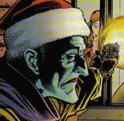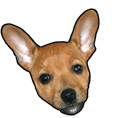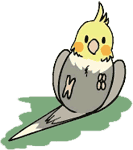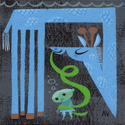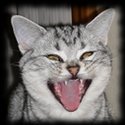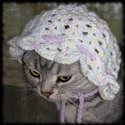|
 Herding is one of the oldest working purposes for dogs. There are a number of dog breeds around the world that have traditionally worked stock, and many continue to this day. Stock dogs might work sheep, cattle, goats or even reindeer, as well as chickens or ducks (though herding birds is often an afterthought in a stock dog’s daily work). Livestock guardians are typically not referred to as herding dogs, though they may be referred to as stock dogs.  Herding breeds can be roughly divided into three types: heelers, headers (divided further into strong-eyed and loose-eyed) and tenders. These categorisations refer to how the dog works. A heeler, such as an Australian Cattle Dog or a Corgi (historically), will typically nip at the heels of stock to make them move. They tend to be used for moving cattle. A header (or fetching dog) will drive animals either with the pressure of their gaze (strong-eyed) or their bodies (loose-eyed). The Border Collie is the stereotypical strong-eyed dog, and is characterised by crouching and staring at the stock. Loose-eyed dogs include the Australian Shepherd and the Welsh Sheepdog. They tend to vocalise more than strong-eyed dogs. A tender, such as a German Shepherd or Pyrenean Sheepdog, uses their bodies as a "living fence", guiding stock to graze while preventing them from eating valuable crops or wandering away. Other dogs, particularly Australian Kelpies and Koolies, may use a mixture of different methods. Australian Cattle Dog working cattle Australian Kelpie working sheep Australian Shepherd working sheep Belgian Sheepdog working sheep Border Collie working sheep Corgi working sheep (herding instinct test) German Shepherd working cattle Pyrenean Sheepdog working sheep Welsh Sheepdog working sheep  Corgis, Rough Collies and Shetland Sheepdogs are generally not used as working dogs now. The traditional spitz-type working Sheltie has been replaced with the showier animal of today, and it is rare to find a Rough Collie with the instinct. Although these dogs can be worked, and have demonstrated the instinct in herding tests, they typically aren’t, especially in their native areas. In the UK, the Border Collie is the quintessential working stock dog. It is uncommon for a farmer to have anything else (except in some parts of Wales). Border Collies are so prevalent that many people would refer to them just as ‘sheep dogs’ or ‘collies.’ The Rough Collie is not the dog in question if someone in the UK is discussing a ‘collie.’ Corgis, Rough Collies and Shelties are generally worked only when a breed enthusiast wants to prove that they can, and they would be used only on a small scale hobby farm.  The herding breeds are popular pets, and this is not always a good thing. Many people fail to understand the high energy of the breeds; even Corgis, Rough Collies and Shelties can be too highly strung for many people. The herding dogs have traditionally been required (and in many places, with many dogs, still are required) to travel long distances, every single day, moving stock from one place to the next. Their needs for physical and mental stimulation are greater than most other breeds of dogs; they are typically not couch potatoes, content with a two mile walk a day. Their temperaments can vary quite drastically from one breed to the next (and even within the breed), with some dogs being incredibly soft, others much harder. They are all intelligent animals, which can be great for some dog owners, and an absolute nightmare for others.  Herding breeds are a common sight in dog sports (some more than others), and they generally do well in them. Border Collies and Shelties usually dominate their categories in agility, and Border Collies (or BCs mixed with other breeds, such as Staffordshire Bull Terriers, Jack Russells and Whippets) are incredibly common in the higher levels of flyball. Dog sports can be an excellent way for a pet owner of a herding breed to drain away some of that energy, but breeding specifically for sports is a can of worms. It can produce dogs that are unfocused balls of hyperactivity, dogs which have no off switch, and which cannot settle when not “working” or at all in a non-sport home.  Showing is another point of contention. The Rough Collie, for example, is a show dog now. It is bred for the ring, by show ladies, and is often more suitable than other herding breeds as a pet for the less active owner. Until recently, despite their popularity, Border Collies were not a recognised breed. BLAH. Working lines and show lines tend to be quite far apart; show breeders focus on what the dog looks like, and working breeders focus on what the dog can do. For show ladies, the mongrel herding sheep on the average English farm is not a “true” Border Collie. For farmers, the over-hairy, driveless animal prancing around the ring is not even worthy of the “herding dog” name. In other breeds (such as the Australian Shepherd), the line between show dog and working dog may not be drawn quite so distinctly. Fraction fucked around with this message at 17:14 on May 13, 2013 |
|
|
|

|
| # ? May 6, 2024 18:43 |
|
List o' herding dawgs: Altdeutsche Hütehunde/Old German Herding Dogs (Germany) Australian Cattle Dogs (Australia) - breed post Australian Kelpie (Australia) - breed post Australian Koolie (Australia) Australian Shepherd (America) - breed post Australian Stumpy Tail Cattle Dog (Australia) Basque Shepherd Dog (Basque) Bearded Collie (Scotland) Beauceron (France) Belgian Shepherd Dog [Groenendael, Laekenois, Tervuren and Malinois] (Belgium) Bergamasco Shepherd (Italian Alps) Blue Lacy (America) Border Collie (England/Scotland border) - breed post Bouvier des Flandres (Flanders) Briard (France) Cardigan Welsh Corgi (Wales) - breed post Carpathian Shepherd Dog (Romania) Catahoula Leopard Dog (America) Catalan Sheepdog (Catalonia) Croatian Sheepdog (Croatia) Dutch Shepherd (Netherlands) English Shepherd (America) Finnish Lapphund (Finland) German Shepherd Dog (Germany): write up on tending - the GSD thread Huntaway (New Zealand) Icelandic Sheepdog (Iceland) Kerry Blue Terrier (Ireland) Lancashire Heeler (England) - breed post Lapponian Herder (Finland) Leonese Sheepdog (Spain) Mudi (Hungary) New Zealand Heading Dog (New Zealand) Norwegian Buhund (Norway) Old English Sheepdog (England) Pembroke Welsh Corgi (Wales) Picardy Shepherd (France) Polish Lowland Sheepdog (Poland) Portuguese Sheepdog (Portugal) Puli (Hungary) Pumi (Hungary) Pyrenean Shepherd (France/Spain) Rottweiler (Germany) Rough Collie (Scotland) Samoyed (Russia/Siberia) Schipperke (Belgium) Shetland Sheepdog (Scotland) Smooth Collie (Scotland) Soft-Coated Wheaten Terrier (Ireland) Spanish Water Dog (Spain) Swedish Lapphund (Sweden) Swedish Vallhund (Sweden) Tibetan Terrier (Tibet) Welsh Sheepdog (Wales) - breed post White Swiss Shepherd (Germany) If anyone wants to do a write-up of one of the herding breeds, that’d be awesome. Otherwise y'all will be stuck with whatever I manage to pull together from research. Fraction fucked around with this message at 22:16 on Jun 26, 2013 |
|
|
|
For the right owner, a herding breed dog can be an amazing pet. Owners regularly comment on how their dogs seem to be able to read their mind. They are smart as whips, willing to do almost anything asked of them, and make great jogging or biking partners, able to go for as long as their human will let them. In the wrong hands, however, they are a disaster. If they are not given appropriate outlets for their energy, they will tend to find their own destructive ways to release that energy. That same intelligence and exuberance that caused a person to want a working breed can lead to them ripping apart furniture, harassing other animals, herding children or chasing down and biting joggers. It is not enough to merely physically tire out most herding breeds. They were bred to constantly have their minds challenged. Sheep dogs have to make sure, at all times, that their flock remained together (unless they were told otherwise), and would have to position themselves to put just the right amount of pressure on a flock, without spooking them. Cattle dogs have to constantly read the stock animals’ body language so that they didn’t get kicked in the face. Although nothing can truly replace work for a stock dog (though herding trials and lessons may come close), there are ways for the pet owner to exercise their dog—and prevent it from therefore eating their house. As was mentioned in the OP, herding dogs are a common sight in dog sports. Agility is a good way to challenge the body and mind of a dog. Obedience and rally-o can work a dog’s mind. I’m personally not sold on the usefulness of flyball for herders, after hearing about the dogs bred for it (go-go-go dogs with no off switch). For those who can’t or won’t go into dog sports, trick training is a great way to mentally tire a herding dog out, and simple things like feeding dogs from food balls or wobbler/pyramid toys can help take the edge off of a dog’s mental energy requirements. Herding dogs may also enjoy tracking or scent work, which can be done in one’s house or in more formal classes. Training for things like the Good Citizen Scheme can be an effective measure too. One of the things that a herding dog pet owner should keep in mind is controlling the dog around stock. Where possible, dogs should be stock-broken as puppies, and certainly shouldn’t be unleashed around stock. In the UK, farmers have the right to shoot a dog they consider worrying their animals; and herding breeds are often the worst for doing exactly that. If your dog isn’t actively working stock, it likely shouldn’t be off leash around them. Herding dogs have typically been considered dogs that cannot ever be housed in a small house or a flat or apartment. However, this isn't true. If you have a large house with a garden, that doesn't necessarily mean the dog will be any happier than in an apartment. A herding dog can't simply be left in a garden all day, or they will make jobs for themselves (barking at neighbours, digging up plants, fence fighting, etc). If a herding dog is adequately exercised, it can live almost anywhere. With all dogs, the saying is that a tired dog is a good dog; and a tired herder is a good herder. The key is to make sure they are given those appropriate outlets for their drives and energy, so that your neighbours don't beat you up because the dog has decided that guarding your windows from pedestrians, animals and blowing leaves is It's Purpose In Life. Fraction fucked around with this message at 15:18 on May 13, 2013 |
|
|
|
Will I be allowed to spam the poo poo out of this thread with pictures of my sister's Aussies? 
|
|
|
|
You are not just allowed but hugely encouraged!
|
|
|
|
Can I GSD sperg in here too or should that stay in the GSD thread? I'm working on a post about the GSD's herding style and sheep tending in Germany.
|
|
|
|
That's up to you! I didn't mention GSDs in the OP because of the GSD thread, but you sure can sperg away 
|
|
|
|
Yay! E: By the way, when you were talking about the main styles of herding in the OP you forget tending. Tenders don't use the eye and are "living fences" rather than driving and gathering dogs. Triangulum fucked around with this message at 16:16 on May 13, 2013 |
|
|
|
Postin' to report that owning a herding dog is Here's my (no longer with us) little herdin' Chunky Grump Pup:  Doing the collie stalk:  Get a Border Collie to do anything with the power of thought alone! Here, Maggie is finding my games tedious:  A little taster of BC obsessiveness, in this case, light on the ceiling: https://www.youtube.com/watch?v=bVp-Iw0xqqM And playfulness. Sometimes, you can break them out of the I AM ALWAYS WORKING mindset: https://www.youtube.com/watch?v=QFnAnFJISoE Edit: also way outta control overfluffy 
Wabznasm fucked around with this message at 00:19 on May 14, 2013 |
|
|
|
Triangulum posted:Yay! Wabznasm posted:Postin' to report that owning a herding dog is This is a fantastic dog. Good dog, Maggie. VVV Done and dusted! Fraction fucked around with this message at 17:14 on May 13, 2013 |
|
|
|
Yep, the Northern European shepherd dogs (Dutch, Belgian, German) are all tenders as are Bouvier des Flandres, Briards, Pulis, Beaceron, and Pyrenean Shepherds. Triangulum fucked around with this message at 16:46 on May 13, 2013 |
|
|
|
I would say that Germany, Netherlands and Belgium are a part of Western, not Northern, Europe. However Northern Europe does have it's own herding breeds. Lapponian Herders, Finnish and Swedish Lapphunds all herd reindeer and Icelandig Sheepdog and Norwegian Buhund have been mainly used with sheep, while Swedish Vallhunds are cattle herders. This is Healy with reindeer:  She was overly excited with them, but could probably work as a herding dog up north like both her parents have done. Healy has also some experience with sheep, cattle and stubborn ponies... I'll post pics of her working, if I stumble upon some more.
|
|
|
|
Reindeer herding looks awesome. I bet she had a blast! Would you like/be able to do a write up on the Northern Europe breeds (or the ones you're familiar with, at least), Riiseli?
|
|
|
|
Riiseli posted:I would say that Germany, Netherlands and Belgium are a part of Western, not Northern, Europe. Yeah I'm retarded, sorry. I'll take the Germans, Dutchies, and Belgians unless someone else really wants to do a write up on them. The three are so closely related and serve such similar purposes that it seems a little silly to split them up. Triangulum fucked around with this message at 17:33 on May 13, 2013 |
|
|
|
My first dog was a BC. She'd lived on a farm for her whole life (seven years) before we picked her out from the rescue center. She turned out to be the best dog ever, especially for inexperienced first time owners-very patient, expressive, laid back, and of course intelligent as hell. As well as adorable. She had the most fantastic old lady eyebrows at the end of her life. This was the very last photo I ever took of her:  She died at the age of 13, very suddenly. I was away and was never able to get the full story of what happened. My parents got another dog after she died, unable to handle not having one around. He was nine months old, and again from a farm, given up because he "chased the chickens".  They claimed he was a tricolour BC, but he seems more like a BC/GSD mix. He's filled out and become fluffier as he grew up, and has more white on him now. At three years old, when chasing a ball in the park he doesn't approach the amount of stamina my dog had even at the age of 13.
|
|
|
|
Battle Pigeon, your BCs were/are adorable. The male could well be just BC. My puppy, Kalli, and her mother are both predominantly black and tan border collies. Kalli:    Bet (right): 
|
|
|
|
Max (Australian cattle dog) and Pistol ("Texas Heeler" Australian shepherd x ACD mix) Majestic creatures. I used to do agility with Max and he loved it, but he's got some arthritis in his back that was hurting him pretty bad once we started doing more than one obstacle in a row so we had to quit. Pistol is going to start with the next beginner class in September. Max is not good at being a working dog, he doesn't like to go outside when it's above 90 degrees out or raining. We got him from the humane society and they picked him up as a stray so we don't really know what his background is, but we suspect he was a farm dog since we live in a pretty rural area and he has a docked tail and a bunch of scars. People comment that he's a little small for a cattle dog/doesn't have the proper markings, so he could be mixed with something else. Or he could just be a small ACD. He's 40 pounds so he's not THAT small. He shows his affection by biting me (he'll climb into my lap and gently gnaw on my chin). We have no idea how old he is, the vet estimated around 5. Pistol used to be a farm dog, but he got kicked off his farm for eating their chickens so I offered to foster him and he never left. He's REALLY smart but has the attention span of a flea so getting him to sit down and pay attention for long enough to learn a thing is difficult sometimes. He is literally the cuddliest dog I've ever met. He's almost 18 months old. When they're both properly tired out they're very snuggly
|
|
|
|
 This is Ginny, my Australian cattle dog. She's probably around four years old now. She was two when we adopted her, and had come across the country on a busload of dogs that had been pulled out of a puppy mill. The shelter told us that after the mill had been cleared out, the owner came out of his house dragging his frightened, overweight pet dog on a leash and told them "take this one too." That was Ginny. She came to us about fifteen pounds overweight, mannerless, and not housebroken. The first night I tried charging a clicker with her, she fell over onto her side and opened her mouth as if waiting for food to rain down on her. She dove onto the kitchen table and stole my dinner right off of my plate. My now-husband and I very quickly realized how naive we'd been for bringing a young, untrained cattle dog into an apartment situation. We did our best to keep her well-exercised, and she surprised us by being a drat good apartment dog. Our landlords once asked us if we took her to work with us during the day, because she stayed so quiet they never would have even guessed she was there. She is scary-smart, and after our first few failings with the clicker something finally, well, clicked in her brain, and suddenly she could learn anything and do anything. She thrives on routine and is the laziest of couch potatoes during the day while we're at work (and on weekends when we're not at work-- there is no getting this dog to budge from the sunny spot on the couch between the hours of 9 and 5). She demands close to 100% of our attention in the evenings. She shows affection by biting, she shows excitement by biting, she communicates everything by biting. If she hasn't put her mouth on something, it means she just hasn't noticed it yet. She has never bitten me in aggression, and has never bitten me hard. If she had a t-bone steak in her mouth, I'd be comfortable reaching right between her jaws and pulling it out. She once nailed my finger accidentally while we were playing tug, and she noticed she'd broken skin before I did, and went slinking off offering all kinds of appeasement behavior and wouldn't touch the rope anymore. If it's her dinner time and I sit down at my computer, she'll butt me right out of the chair and then nip my heels in an effort to herd me to the kitchen. She herds our beagle around the yard and absolutely will not tolerate any birds, ever, anywhere in the vicinity. Now we own our own home so she can run around and chase birds in the yard to her heart's content. She misbehaves for attention. If no one is home and she's bored, she sleeps. If someone is home and she's bored, she'll pick up some household item and sit there with it in her mouth, waiting to be noticed. As soon as you notice her, she'll destroy whatever she's holding. She once swiped a napkin off of my mom's lap and then sat there next to her at the kitchen table for a good several minutes waiting for my mom to realize that she had it. Then she gleefully shredded it and ran off. She's also the most person-oriented dog I've ever known. She likes eye contact and will follow my gaze if I look at something. She looks to me for direction. She is my shadow. We have a magnet on our fridge that's a picture of a cattle dog with the phrase "I'm right behind you" under it, and that sums her up perfectly. If I'm on the couch, she's on my lap. If I'm in bed, she's right next to me with her head propped up on my leg. She is never happier then when she is near. I have seriously never known a cuddlier dog.
|
|
|
|
Great, now I've added like five breeds to my list of "daydream about owning even though I never will" dogs, THANKS, FRACTION.  Good thread. I tell my friend that he and his dad got REALLY lucky with their rescued border collie. She is very chill, well-behaved (with no real training), and very capable of switching off... which is good since they really don't do anything with her. She will do the collie stalk when she sees other dogs she wants to play with, but that's about it. She's pretty skittish of new people but is easily won over with treats. I've been trying to work with her a little on training for fun and she has the exact same problem that my dog has - she doesn't really "get" the whole thinking on her own thing. She's very cute and sweet though. I get all
|
|
|
|
A friend of mine got a border collie puppy while she lived in Germany and taught him all his commands in Italian (her native language). He was a pretty typical border collie as far as I know, as in pretty high strung and high energy. She tried her best by him, but that dog had infinite energy. Apparently he was a much more neurotic dog after having the trauma of slipping his lead and getting hit by a car. After that easily imprinted fearfulness on any situation that startled him. He was a fear biter and couldn't be trusted around children. He had to be taken to work with his peoples, which is where I met him, so he wouldn't be even more neurotic. He tried to herd cars while on walks and you couldn't pet him because sometimes it freaked him out. I learned his commands in Italian and spent a lot of hours tossing his ball or one armed lobster for him. When he first met me he tried to guard the car from me, and honestly I was pretty scared of him. After one of our play sessions though, I think he accepted me as someone good and always brought me a toy when I showed up. He died of a heart tumor very suddenly at the age of 7. Shortly afterwards my friends became pregnant. They had been talking about whether or not they would have to send him to a farm to live out his days, as they wanted a family but knew he wouldn't be able to handle it with all his problems. He seemed happier at the farm when they brought him there to board during travel, but it was a decision they just couldn't make as it would break their hearts. I'd like to think that somehow he knew that it was time to go and be a Good Dog forever. So yeah, herding dogs are pretty amazing, but I imagine it's similiar to raising a chimpanzee.
|
|
|
|
^^ That sucks, Pandaid. Some dogs (especially byb or sports dogs) just can't ever stop. It's important to teach any herding dog to be able to chill out, so that you don't kill it and vice versa. ACDs represent! I love how expressive they always are (especially Pistol; his various faces make me laugh so much). Ginny's before/after pictures are mindblowing. She was such a whale. Skizzles posted:Great, now I've added like five breeds to my list of "daydream about owning even though I never will" dogs, THANKS, FRACTION. I'm happy to help! Your friend's BC sounds cool. Got any pictures of her? Sometimes they're surprisingly laid back! I've been smitten with/wanted a BC since I was a small child and now I gots one! Do you think you'd get a rescue GSD or one from a breeder? (Get a Groen as well as a GSD please and thank you) PS everyone there is a disturbing lack of pictures ITT. Post more.  Ginny/Aquatic, would either of you guys like to do a breed post for ACDs? Ginny/Aquatic, would either of you guys like to do a breed post for ACDs?
|
|
|
|
I'll just leave this here. http://imgur.com/a/bFl4z Blue dog is Sam, she's my ACD. Got her from the pound five (6?) years ago, my best bud and goes everywhere with me. The golden is Alley, she's my girlfriends dog. The Aussie shepard is my pop's dog, she's a spoiled pet, 100% and has zero work. Sweet dog though, got her from the pound too, 3 years ago I think. Small black dog's name was Ben. A friend gave him to my pop because he didn't have anywhere to keep him due to a move. Cool little dog, great personality. He got hit by a truck on the highway, that sort of thing happens when you live on a highway. Seeing everyone else's ACD's and sheps makes me tingle a bit. Anyone have Catahoulas or Hanging Tree dogs? Used Sunlight sales fucked around with this message at 06:16 on May 14, 2013 |
|
|
|
Fun fact: If an Australian Shepherd closes its mouth for more than a split second it will explode. The barking reduces the pressure to a manageable level.        
|
|
|
|
another fun fact about Aussie sheps...If they stop moving they fall asleep.
|
|
|
|
Lapponian reindeer herders bark when they herd. Here is Pi doing what he does best:
|
|
|
|
It sounds like ACDs can have good off switches. Mine is some sort of a mutt and is relatively low energy (couch potato, hates being outside if its warmer than 75 or colder than 50) and his favorite activities other than sleeping are catching a thing (has to be alive), trying to nudge me to do things or chewing on a thing. One time he ran around me in circles really fast but I think it's because I broke his brain. I spend a lot of time telling my friends who want a dog not to get an ACD because they think Bailey is super typical of the breed.
|
|
|
|
Don't take my dogs for typical unless you live way out in the country , have unlimited space for your dogs to run and keep them with you all day. My dog is like my daughter, and she goes everywhere with me.
|
|
|
|
Fraction posted:I'm happy to help! I sure do have pictures.  Gettin' pettins from said friend.  And then later she fell asleep on my foot.   My friend and his dad have always been under the impression that she's a BC mix, but I thought she was just straight up BC. Apparently she was found under a porch with a sibling who looked a lot different, I think. I don't know anything beyond that. So who knows. As for the GSD, I've always thought I'd lean toward a rescue GSD since I don't know that I'm going to want anything SUPER intense, and they're so abundant in shelters/rescues. But I have a growing desire to start with a shiny new puppy, so who knows. I "know" a trainer who works with Groens and was all "we have connections with breeders all over North America, let me know if you want me to get you in touch with any!" and I'm like "DON'T TEMPT MEEEEE."
|
|
|
|
Cardigan Welsh Corgis Corgis are the smallest dogs in the herding group, weighing in at 20-25 lbs for the Pembroke, 25-34 for the Cardigan. Both are from Wales, originally, and looked very little like they do today.  This is Mon, considered the last old-type or Bronant type Cardigan. You'll notice he's got drop ears rather than the prick style that corgis are famous for. He died in 1929, struck by a motor van. Cardigans are the older of the two corgi breeds. Their name comes from the Cardiganshire region of Wales where they originated. They are descended from the Teckel family of dogs, which also produced Dachshunds. Legend has it that the breed has been around in Wales for about 3,000 years, but no one really knows the truth of that, or what the breed looked like in those days. They were first brought to the US in the 1930's, but have never achieved the popularity that the Pembroke Corgi has - which makes literally zero sense to me, as a Cardigan owner.  Bob Llwyd (1917-1935), the "founding father" of the Cardigan breed standard. He was BOB at Crufts in 1927, and all of today's Cardigans can be traced back to him one way or another. Cardigans and Pembrokes were shown as one breed in the KC until 1934, so for 9 years the two intermixed and were occasionally bred together. When they were finally recognized as separate breeds, the Pembroke judges still predominated the show scene and hastened the Pem to its current heights of popularity through show preference.  Glanmore Robin, one of Bob Llwyd's sons  UK CH Golden Arrow, another son of Bob Llwyd Cardigans were bred to herd cattle originally, which meant that a solid body, short legs for ducking hooves, and a driving style were all selected for, leading to today's Cardigan structure and herding style. Later they were put to sheep and excelled there as well. Because they were all-purpose farm dogs, Cardigans also have a well-developed alert bark and can even rat.  Bussleton Chips and Bussleton Joy, two founding members of the Cardigan breed from 1936, parents of:  UK CH Bussleton Brock, born 1941 Like all herding dogs, Cardigans are wicked clever. They require a job or something to think about, or they will get somewhat destructive. They like to sit back and ponder a puzzle before diving in, which also reflects how they interact with people. Unlike the Pembroke, Cardigans are slightly more reserved in greeting new people. They are not shy, however they prefer to be "introduced" and are less effusive. Though short in leg, they are big in personality. They do not like to be left out of family fun, and will always want to participate when their owners are doing something. However, they can also settle and relax. Cardigans also come in more colors than most of the herding breeds - a legacy of their early years as functional farm dogs. Cardigans can be red and white, sable, brindle and white, black and white, or blue merle, all with or without tan or brindle points. White should not predominate, and only the merles may have blue eye(s).     a veritable rainbow of corgis The most common health issues tend to be chronic hip dysplasia, IVDD, cancer, degenerative myelopathy, and progressive retinal atrophy. The more Cardigans I see, the more I'm struck by how...weird and abnormal mine is. Her siblings all conform to breed standard, and her lineage is superb, but Neigé doesn't really look much like other Cardigans. In terms of temperament and personality, she's pure Cardigan - that mix of intelligence and biddability, her clownishness, all the things that are important for the breed - but appearance-wise, well...  Her littermate Luca vs  My little weirdo  fat Cardigan at the dog park + bonus random byb pembroke Anyway Cardigans are great and I love them and will probably always have at least one.
|
|
|
|
The Border Collie A Border Collie displaying the infamous Collie Crouch. The Border Collie is one of the most instantly recognisable dogs in the world. They come in a variety of sizes and shapes, with many collies being so far from show ring standards that they would seem almost another breed. Like many working animals, they have been bred as a type – bred for their function, not for their looks. In Britain, “sheepdog” is synonymous with “Border Collie.”  Early Border Collies in the Netherlands They originated in the England/Scotland border, and mentions of the Collie/Colley (which is disputed to come from either the Gaelic colley (“useful”) or the old English colley/coly (“black”)) can be found in passages at the end of the nineteenth century. These collie dogs may not have been Border Collies – indeed, BCs didn’t possess that name until 1915, when James Reid of the ISDS referred to them as such, to differentiate them from the Scotch Collie (in its Rough and Smooth variants), which even then were being bred just for the show ring. Images of the collie/colley from the end of the nineteenth century often depicted either a Scotch-like animal, or a Border-like dog, or another type altogether. The farm dog of Britain was a workman’s dog. They were not flashy, and in some instances were not pretty. This remains the case in many instances – a dog that is registered as a Border Collie may look nothing like what one expects. Like the terriermen who mixed terrier and bull blood in their foxing dogs, farmers have often bred their stock dogs with other breeds. The original sheep dog was expected to be a jack of all trades; to herd sheep, to guard the farm, and to kill vermin. Many Border Collies on working farms will still do all of these things. Working dogs have always been compared against each other, but rarely beyond village borders, until 9th October 1873. In Bala, Wales, the first official sheep-herding trial was held, with ten dogs competing and around three hundred people spectating. It was won by a Scottish man and his black and tan sheepdog; James Thompson, with Tweed. Trials in other areas of the UK were quickly held: Scotland in 1874, England in 1876. The winner of the first English trial was Walter Telfer, brother of Adam Telfer, the breeder of Old Hemp.  Old Hemp, 1893-1901 Old Hemp is widely considered the progenitor of the modern Border Collie. He worked much more quietly than other trialling sheepdogs, using the strong-eye now characteristic of the breed to move the sheep. He is estimated to have had more than 200 offspring, though it is unknown if he even won a single sheepdog trial. His offspring placed well, though: between 1906 and 1951, each of the twenty nine BCs that won the International Sheep Dog Society championship were his descendants.  Wiston Cap, 1963 Other Border Collies have had a distinct influence on the breed. Wiston Cap, born 1963, is one of them. Most modern BCs can be traced back to him (and, through him, to all of the early registered ISDS dogs). Wiston Cap sired three Supreme Champions and is the grand-sire of a further three. Other highly influential dogs in the breed are: Old Kep, J. M. Wilson’s Cap (or Wartime Cap), Gilchrist’s Spot. Many sheepdogs with an ISDS pedigree can trace their dogs back to several of these dogs, alongside the aforementioned Wiston Cap and Old Hemp.  Puppies showing some of the BC’s many colours. Despite this relative lack of genetic diversity, the diversity in the working sheepdog before these highly bred dogs means that the Border Collie remains a varied animal. They are medium-sized dogs, thickly coated (either with a slick or rough coat), and come in many colours. The black and white or black, white and tan dog is the traditional collie, but they can also be found in black tricolour (black, tan and white) red and white, red tricolour, sable, blue, lilac, red merle, blue merle, slate merle, brindle and ee red (Australian red). Most of these colours have been developed in the show ring, though some have crossed the showy colours back into working lines. It is not uncommon to find red or merle (either blue or red) dogs working on farms. Even sable is beginning to reach some working lines. It is rare to find an all-white working dog; due to a mixture of superstition and, likely, the merle gene (i.e. double merle puppies) farmers have traditionally avoided predominantly white dogs. The eye colour of a BC can vary from deep brown to amber to blue, and they may have erect, semi-erect or dropped ears. Although medium sized dogs, they range greatly in size.  A working BC.  Westminster Best of Breed With the increasing interest in dog showing, the BC has had to deal with a whole heap of issues. The show ring’s standard (whether KC, AKC, etc) calls for a dog to conform to a physical ideal – and since the very essence of the British sheep dog is that it has been bred for function, not appearance, a working BC is often far from what a show ring calls for. It was only in 1976 that the Border Collie was accepted into the British Kennel Club. Dogs that had been registered with the ISDS were able to be shown in the ring; those of the “Border Collie type” but not registered were able to be registered as Working Sheepdogs, and to compete in the Sports sections of the KC, but not in the show ring. These still apply today. The BC found in the show ring is, in many ways, a different animal than the dog found herding sheep on a remote farm. Show BCs have come under great criticism from working dog enthusiasts; they have been nicknamed “Barbie Collies,” and it is said that they are rapidly being removed from their working drives. Although a show BC is still likely to be a moderately high energy dog, they likely aren’t capable of the work of a common farm dog. In being bred for perfectly shaped eyes on perfectly shaped heads on perfectly shaped bodies, with perfectly long soft hair, they have been set apart from their roots. Border Collies, like other herding dogs, can make excellent or terrible pets. It is not uncommon for pet owners to buy dogs from working litters; unlike other BC “lines” (e.g. the sports-bred collies), these dogs are usually satisfied with the exercise and mental stimulation required for almost any stock dog, and as such retain an ability to relax when not working (the “off switch”). They were popularised as pets in the UK by programs such as ‘One Man and His Dog’ (1976-1999 for the regular series; 1999-2011 for the yearly Christmas special), and unfortunately this meant a lot of dogs were bought on impulse, with no knowledge of how to care for them. Make no mistake, a BC is a high energy dog, but for the right (active, thoughtful) owner they can be downright amazing.
|
|
|
|
Skizzles posted:
I dunno, she looks 'pure' BC to me too. They do come in a variety of packages! I originally intended, until fairly recently, to rescue a BC - like GSDs they're a common sight in rescues. The opportunity to mould your own dog from scratch was too big a temptation for me to pass though. If you went with a puppy, would you be more likely to go GSD or Groen? ButWhatIf thank you for the Cardi post, you are awesome, etc. I know you enjoyed the chance to sperg about corgis
|
|
|
|
Fraction posted:PS everyone there is a disturbing lack of pictures ITT. Post more. I'd be happy to work up a breed post if no one else with more ACD experience wants to step in!
|
|
|
|
You asked for it Fraction! Posting a load of photos to show BCs aren't *all* work, they can be pretty goofy dogs too:            (I miss her  ) )
|
|
|
|
Pictures of corgis actually working never fail to make me smile. Just look at those ridiculous guys.
|
|
|
|
Fraction posted:Battle Pigeon, your BCs were/are adorable. The male could well be just BC. My puppy, Kalli, and her mother are both predominantly black and tan border collies. I've been following your thread.        These two are the most recent ones I have of him.   With a clearer view, what do you think? BC, or BC mix?
|
|
|
|
Fraction posted:I dunno, she looks 'pure' BC to me too. They do come in a variety of packages! I haven't actually thought too hard about it. It'll be quite a while before I'm really settled and in a good place to get a dog "for real," so I was going to put some more research into it until then. If I did end up going the breeder route chances are I'd just go all out and go for the Groen. However, I also haven't really decided what I'd like to do with the dog. Sports? If so, which one(s)? SAR work? Maybe even venture into some Schutzhund/IPO? I haven't really decided since I still have plenty of time to think about it.
|
|
|
|
My parent's christmas card from last year. All BCs.
|
|
|
|
Ginny Field posted:I'd be happy to work up a breed post if no one else with more ACD experience wants to step in! Go for it, I don't know much about them except that I own 1.5 of them. The cattle dog:  Good at being cute:   Making stupid faces:   And getting in the way when I try to do household chores:   
|
|
|
|
Growing up my family had herding dogs. The best was Duncan, a border collie/cattle dog mix who was excellent with cattle. We did some AKC trials with him (entered as a gigantic cattle dog), and he was very successful. He loved working with cattle, and we even had a farmer offer to buy him off us once (we politely declined). He was also the hardest dog I've ever known. Incredibly intelligent, extremely active and with a very strong herding instinct. Motorcycle riding down the street? Time to pull him inside, because he could jump a 12 foot fence. Once he got older, he settled down and was a wonderful pet. He died about a year ago at the age of 17. Here's an awful picture: 
Seven Hundred Bee fucked around with this message at 03:12 on May 15, 2013 |
|
|
|

|
| # ? May 6, 2024 18:43 |
|
The Australian Kelpie Kelpies. The Kelpie is a medium-sized stock dog hailing from Australia. They are bred in a variety of colours – black, black/tan, red, red/tan, blue, blue/tan, fawn, fawn/tan and cream. They are primarily a working breed, used particularly for mustering and droving stock. They are commonly used on sheep, cattle and goats. Working line dogs may have smooth, short or rough coats, though show line dogs tend only to have the smooth coat. Like several other herding dogs, the Kelpie hails from the collie/colley dogs of Britain. Some of these dogs were imported to Australia to work stock in the early 19th century, and were bred to other types of dog to create an animal that could work sheep without direct supervision. It has been suggested that dingoes were used in the formation of the Kelpie, and certainly some people have bred dingoes with their Kelpies since the original breed formation. The first ‘Kelpie’ was a black and tan female with floppy ears, bought by Jack Gleeson in 1872. She was named after the mythological Celtic kelpie. ‘Kelpie’ was mated to an all-black collie-type dog, ‘Moss’, and whelped a litter soon after. She was mated again to a black/tan dog out of a litter of black/tan Scottish stock dogs, ‘Caesar’. Some of ‘Caesar’s’ siblings were red dogs. Gleeson’s ‘Kelpie’ birthed a black and tan bitch, King’s ‘Kelpie.’ Like her mother, King’s ‘Kelpie’ was a good stock dog, and her outstanding performance at the first Sheep Dog Trial in New Wales led to a creation of a new strain of dogs. These dogs were originally known as Kelpie’s pups, but by the end of the 19th century any dog that looked similar in type to these animals became known as a Kelpie, regardless of its origins.  A working Kelpie. Despite its similar origins to the Border Collie, the Kelpie’s herding style is quite different. Much of the Border Collie’s style and slightly more standardised appearance came about at the end of the nineteenth century, thanks to Old Hemp, when the Kelpie strain was already becoming established in Australia. Perhaps due to their mixed heritage, Kelpies use a mixture of strong eye and loose eye. They rarely lie flat on the ground as a BC might; they prefer instead to stand or crouch whilst managing their stock. Good working Kelpies will prevent stock from moving away from the stockman. This is essential for work in isolated gorge country, in which a Kelpie must silently move ahead of the stock and block them from continuing until the stockman appears. The Kelpie’s signature move is to jump on the backs of sheep and walk across them to reach the other side. The first standard for the Kelpie was published by Robert Kaleski in 1904, and adopted by the Kennel Club of New South Wales. There was a quick divergence in dogs bred for work or show. Working Kelpies were (and still are) registered with the Working Kelpie Council and/or the State Sheepdog Workers Association. Because these dogs are working animals, the WKC permits a wide variety of coat colours, which may or may not conform to the show standard. Only Kelpies registered with the Australian National Kennel Club may be shown in Australia. Outside of Australia, the American Kennel Club (AKC) does not recognise the Kelpie; the United Kennel Club (UKC) and Canadian Kennel Club (CKC) both recognise them, and allows for them to compete in their events.  A show line red Kelpie. Show Kelpies do not differ hugely in appearance from the average working Kelpies, though they are generally heavier and shorter (i.e. stockier) than their working counterparts. They are restricted to solid colours – black, chocolate, red, blue, fawn, black/tan and red/tan – and must be short-coated with pricked ears. The selection for appearance rather than working ability does not appear to have significantly harmed the breed as a whole; show dogs will be less driven (if they have the working drives at all), but they continue to keep a work-like appearance. They certainly have not gone the way of other working dogs bred for show, such as the German Shepherd, perhaps because of the relative lack of show ring interest in them outside of Australia. The Kelpie is not simply Australia’s version of the Border Collie. They have been bred to work much more independently than the dogs they would once have closely resembled. As pet dogs, they may be more frustrating than the average work-bred herding dog, due to this decision to breed for a more independent dog. They are intelligent dogs, and their versatility means they are good candidates for dog sports. They are generally not dogs that will be content to lie around on the couch all day. They need a job, and if you don’t give them one then they will find one for themselves.
|
|
|





